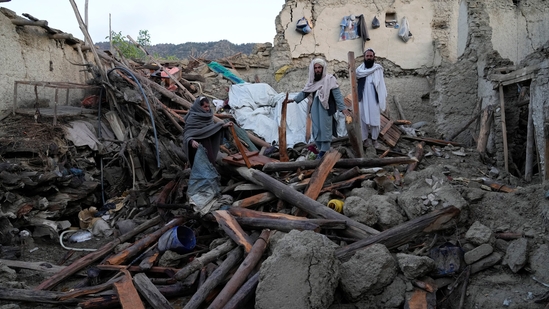Death Toll from Afghanistan Earthquakes Rises to 2060, Says Taliban Government
The death toll from strong earthquakes that shook western Afghanistan has risen to 2060, a Taliban government spokesman said Sunday. It’s one of the deadliest earthquakes to strike the country in two decades.

Summary:
- A powerful magnitude-6.3 earthquake followed by strong aftershocks killed dozens of people in western Afghanistan on Saturday.
- Death toll from the earthquake in Herat is higher than originally reported, with about six villages destroyed and hundreds of civilians buried under debris.
- United Nations gave a preliminary figure of 320 dead, but the figure is still being verified.
- 465 houses have been reported destroyed and a further 135 were damaged.
- Search and rescue efforts continue as more people may be trapped under collapsed buildings.
A powerful magnitude-6.3 earthquake followed by strong aftershocks killed dozens of people in western Afghanistan on Saturday, the country’s national disaster authority said. Abdul Wahid Rayan, spokesman at the Ministry of Information and Culture, said the death toll from the earthquake in Herat is higher than originally reported. About six villages have been destroyed, and hundreds of civilians have been buried under the debris, he said while calling for urgent help.
The United Nations late Saturday gave a preliminary figure of 320 dead, but later said the figure was still being verified. Local authorities gave an estimate of 100 people killed and 500 injured, according to the same update from the UN Office for the Coordination of Humanitarian Affairs. The update said 465 houses had been reported destroyed and a further 135 were damaged.
“Partners and local authorities anticipate the number of casualties to increase as search and rescue efforts continue amid reports that some people may be trapped under collapsed buildings,” the UN said.
Devastation in Herat Province
Disaster authority spokesperson Mohammad Abdullah Jan said four villages in the Zenda Jan district in Herat province bore the brunt of the quake and aftershocks.
The United States Geological Survey said the quake’s epicenter was about 40 kilometers (25 miles) northwest of Herat city. It was followed by three very strong aftershocks, measuring magnitude 6.3, 5.9, and 5.5, as well as lesser shocks.
At least five strong tremors struck the city around noon, causing panic among residents. Houses, offices, and shops were emptied as people feared more earthquakes.
International Response
The World Health Organization in Afghanistan said it dispatched 12 ambulance cars to Zenda Jan to evacuate casualties to hospitals. “As deaths & casualties from the earthquake continue to be reported, teams are in hospitals assisting treatment of wounded & assessing additional needs,” the U.N. agency said. “WHO-supported ambulances are transporting those affected, most of them women and children.”
Japan’s ambassador to Afghanistan, Takashi Okada, expressed his condolences, saying on social media, “I am deeply grieved and saddened to learn the news of the earthquake in Herat province.”
The Taliban urged local organizations and security agencies to provide immediate help to the affected areas, including rescuing people trapped under debris and providing shelter and food to survivors.
Telephone connections went down in Herat, making it hard to get details from affected areas. Videos on social media showed hundreds of people in the streets outside their homes and offices in Herat city.
This earthquake follows a powerful quake in June 2022 that killed at least 1,000 people and injured about 1,500 in eastern Afghanistan.
Follow DelhiBreakings on Google News
Superfast News Coverage by DelhiBreakings.com team.
For Superfast national news and Delhi Breaking Stories visit us daily at https://delhibreakings.com





